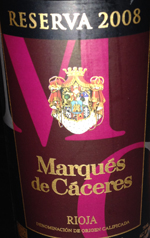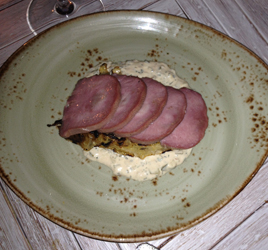
 Note: This is a review under the opening chef, Ben Spiegel. James Kim replaced him in June 2014. The Village Voice filed a favorable review later that year, but the restaurant closed in March 2015.
Note: This is a review under the opening chef, Ben Spiegel. James Kim replaced him in June 2014. The Village Voice filed a favorable review later that year, but the restaurant closed in March 2015.
*
First you have to figure out how to get there, a streetcorner on the edge of the city, where Chinatown meets the Lower East Side. It took me to the last subway station below Central Park that I’d never been to (East Broadway), then a couple of disorienting wrong turns till I found it.
Finally, there it is: Skál, with its box-shaped dining room giving off a warm glow, in an area where most of the storefronts are barricaded shut during the evening. Look a bit closer, and there’s a trendy bar or two, and on the street, plenty of revelers with a purpose, heading to their next watering stop. The busier part of the Lower East Side is four blocks to the north.
You can see faint glimmers of what the New Yorker meant in 2003, when it reviewed Les Enfants Terribles, the last restaurant to occupy this space: “It’s nice that the Manhattan tradition of opening a restaurant in an impossibly lonely, graffiti-bombed corner of town is still in effect.”
A decade later, as it prepared to close, the website Bowery Boogie lamented that, “The Ludlow corridor has become that temple of doom situation, whereby the heart and soul of the neighborhood is being categorically stripped by the hand of gentrification.”
No, it’s not grandma’s Lower East Side any more.
Nowadays, one in ten chefs cooks at Noma for 15 minutes, then opens a New Nordic restaurant. Skál means “Cheers!” in Icelandic, and the here the cuisine hails (nominally) from that Scandinavian nation. But the Canadian chef Ben Spiegel’s tightly-edited bistro menu could be found anywhere, with its Long Island duck wings, Elysian Fields lamb rib, Berkshire pork chop, and Angus hangar steak.
 Root vegetables, grasses, and seaweed dart in and out of the menu, but I saw very little of the New Nordic ethos on the plate, nor even some of the edgier ingredients promised on the website (puffed pig skin, powdered malt vinegar, whipped cod roe).
Root vegetables, grasses, and seaweed dart in and out of the menu, but I saw very little of the New Nordic ethos on the plate, nor even some of the edgier ingredients promised on the website (puffed pig skin, powdered malt vinegar, whipped cod roe).
None of which is to deny that Skál is a most welcoming place. The food is very good, and by current standards inexpensive, with starters and vegetables $5–15, and more substantial plates $14–28. (It does appear that some items in the latter category are not full entrées, such as the $14 duck wings, but I was not entirely sure about that.)
The house cocktails ($13) merit further exploration. I was pleased with the Gurka (Nolet’s Gin, Cucumber Juice, Lime Juice & Pepper), but the Same Same But Different (Makers Mark, Lemon Juice & Blackberry Juice) was too fruity for my taste.
The bread service came with the obligatory Nordic schmear of soft butter, but no knife to spread it with.

If they serve broccoli on Mount Olympus, then Skál’s version, roasted with bread crumbs and duck egg emulsion, is the broccoli of the gods ($11; above).

It’s hard to tell there’s a whole roasted fluke ($26; above) in the photo, but you might just see the head poking out from under an avalanche of accompaniments. Getting to the fish took a bit of work, but once there it was worth the effort.
The dining room is small. It was full at 10:00pm on a Saturday evening, and the music was a bit loud for my preference. Reservations are accepted on the website, which in my case (dining alone) meant a seat at the bar, which was just fine, and I was well taken care of.
For me, Skál is a bit too far away to enter my regular rotation, but if you’re nearby it’s worth a visit.
Skál (37 Canal Street at Ludlow Street, Lower East Side)
Food: Nominally icelandic; bistro cuisine that would work anywhere
Service: Very good for a casual spot
Ambiance: A small, informal, and sometimes loud, but charmingly small room
Rating: ★
 Monday, April 21, 2014 at 08:20PM
Monday, April 21, 2014 at 08:20PM 
 Who’d have thought that a French restaurant that serves meats on a rôtisserie would be one of the breakout hits of 2014?
Who’d have thought that a French restaurant that serves meats on a rôtisserie would be one of the breakout hits of 2014?





































